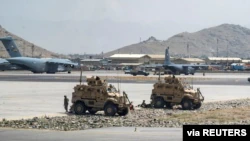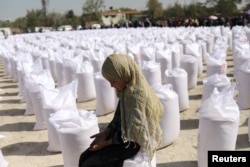The United States is giving Ukraine 16 Mi-17 helicopters that Washington had procured for Afghanistan, a U.S. government agency charged with monitoring Afghan events said Wednesday.
The Department of Defense (DOD) notified Congress in January that it intended to give the Ukrainian government five of the Russian-built helicopters, which had been undergoing maintenance at a Ukrainian facility.
“Ukraine accepted these excess defense articles on March 11,” the Special Inspector General for Afghanistan Reconstruction (SIGAR) noted in its quarterly report submitted to U.S. lawmakers this week.
The report added: “In mid-April, President (Joe) Biden announced a military assistance package to Ukraine that included an additional 11 Mi-17 helicopters that had been scheduled for Afghanistan.”
Mi-17s are mostly used to carry troops and military equipment. Ukraine is one of the former Soviet Union republics which hosts production and repair facilities for the helicopters.
US equipment left in Afghanistan
In its report this week, the
SIGAR also confirmed reports that the fall of the Western-backed Afghan government last August gave the country’s new Taliban rulers access to more than $7 billion worth of U.S. Department of Defense equipment.
“DOD estimates that $7.12 billion worth of ANDSF equipment remained in Afghanistan in varying states of repair when U.S. forces withdrew in August 2021,” the report said in reference to the U.S.-trained and funded former Afghan National Defense and Security Forces.
The SIGAR also clarified, citing the Pentagon data, that $18.6 billion worth of ANDSF equipment was procured through the U.S. Afghan Security Forces Fund (ASFF) since 2005 — not the $80 billion reported by some media. Much of that equipment was destroyed during combat operation, it added.
The equipment includes aircraft, vehicles, munitions, guns and communication equipment, as well as other gear, “in varying states of repair,” according to Pentagon spokesperson Army Major Rob Lodewick.
“Nearly all equipment used by U.S. military forces in Afghanistan was either retrograded or destroyed prior to our withdrawal,” Lodewick said in a statement last week.
Pentagon officials also told VOA that only a sliver of U.S.-owned and operated equipment was left behind when the last U.S. troops departed Afghanistan, estimating its value at just more than $150 million before it was destroyed or otherwise rendered inoperable.
The Taliban seized power from the now-defunct Afghan government in mid-August 2021. U.S.-led foreign troops finished withdrawing from Afghanistan on August 30 after nearly two decades of war with Taliban insurgents.
Afghan air force personnel also flew almost 50 helicopters and fixed wing aircraft to neighboring Uzbekistan as the Taliban took control of the country in a lightning 11-day military offensive. Several more aircraft and Black Hawk helicopters were taken to neighboring Tajikistan to prevent them from falling into Taliban hands.
The SIGAR report quoted the Taliban air force commander and former Afghan Air Force (AAF) personnel as saying that about 4,300 members, half of the former AAF, have joined the Taliban’s air force, including 33 pilots.
“Only a fraction of the 81 aircraft at the Kabul military airport are functional, including six repaired UH-60 Blackhawks,” the report said.
Humanitarian assistance
Meanwhile, the SIGAR report said that the U.S. State Department and the U.S. Agency for International Development (USAID) had paused the majority of development assistance programs in Afghanistan during August and September 2021. Since then, more than a dozen programs have restarted to address critical needs of the Afghan people.
“Efforts in these areas are being implemented through NGOs, international organizations, and other third parties, minimizing benefit to the Taliban to the extent possible,” the report noted.
The United Nations estimates that nearly 23 million people in Afghanistan, ravaged by years of war and the worst drought in three decades, are in need of humanitarian assistance. An estimated nearly 9 million of them remain at risk of famine-like conditions.
The U.N. Children’s Fund (UNICEF) estimates that 3.2 million children in Afghanistan will suffer from acute malnutrition in 2022, with one million severely malnourished children at risk of death if immediate action is not taken.
The Biden administration on March 31 pledged more than $204 million in humanitarian assistance for the people of Afghanistan, according to the SIGAR. This is in addition to $308 million announced on January 11. The U.S. humanitarian aid in Afghanistan and for Afghan refugees in the region since October 2020 now totals nearly $986 million.
VOA’s Jeff Seldin contributed to this report.


